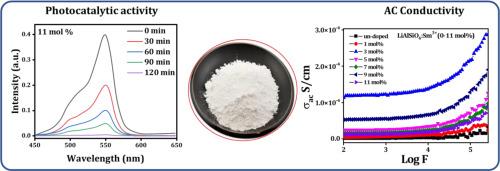Multifunctional Sm3+ doped LiAlSiO4 nanoparticles for efficient photocatalytic water treatment and high-frequency dielectric applications
IF 5.4
3区 化学
Q1 CHEMISTRY, INORGANIC & NUCLEAR
引用次数: 0
Abstract
In this work, Sm3+ doped LiAlSiO4 nanoparticles (1–11 mol%) are successfully synthesized via a solution combustion method and comprehensively characterized using X-ray diffraction (XRD), field emission scanning electron microscopy (FE-SEM), energy-dispersive X-ray spectroscopy (EDX), and Fourier-transform infrared (FTIR) spectroscopy. The optical bandgap was found to decrease systematically from 4.427 eV (undoped) to 4.074 eV for 11 mol% Sm3+ doping, indicating bandgap modulation through rare-earth incorporation. The dielectric behavior is investigated through measurements of complex permittivity (ε⁎), dielectric loss (tan δ), and AC conductivity (σ) across varying frequencies and dopant concentrations. Results showed that both ε' and ε″, as well as tan δ, decreased with frequency, whereas σ exhibited an increasing trend. Notably, Sm3+ doping enhanced the conductivity compared to the undoped sample, confirming its potential for high-frequency dielectric applications. Photocatalytic activity is evaluated using Rhodamine B (Rh·B) as a model dye under UV light. The optimized LiAlSiO4:11Sm3+ sample demonstrated exceptional photocatalytic efficiency, achieving 99.12 % degradation of Rh·B within 120 min. Further studies assessed the effects of catalyst loading 40 mg (73.4 %), dye concentration 5 pp. (99.23 %), pH 12 (99 %), and scavenger agents, revealing critical factors influencing degradation performance. The combined dielectric and photocatalytic properties highlight the multifunctionality of Sm3+ doped LiAlSiO4 NPs for potential applications in environmental remediation and advanced optoelectronic devices.

多功能Sm3+掺杂LiAlSiO4纳米粒子用于高效光催化水处理和高频介电应用
本文通过溶液燃烧法成功合成了Sm3+掺杂LiAlSiO4纳米粒子(1-11 mol%),并利用x射线衍射(XRD)、场发射扫描电镜(FE-SEM)、能量色散x射线能谱(EDX)和傅里叶变换红外(FTIR)光谱对其进行了综合表征。当掺杂11 mol% Sm3+时,光学带隙从4.427 eV(未掺杂)系统地减小到4.074 eV,表明通过稀土掺入实现了带隙调制。通过测量不同频率和掺杂浓度下的复介电常数(ε)、介电损耗(tan δ)和交流电导率(σ)来研究介电行为。结果表明,ε′和ε″以及tan δ随频率的增加而减小,而σ呈增加趋势。值得注意的是,与未掺杂的样品相比,Sm3+掺杂提高了电导率,证实了其在高频介质应用中的潜力。以罗丹明B (Rh·B)为模型染料,评价了紫外光下的光催化活性。优化后的LiAlSiO4:11Sm3+样品表现出优异的光催化效率,在120 min内实现了99.12%的Rh·B降解。进一步的研究评估了催化剂负载40 mg(73.4%)、染料浓度5 pp(99.23%)、pH 12(99%)和清除剂的影响,揭示了影响降解性能的关键因素。电介质和光催化性能的结合突出了Sm3+掺杂LiAlSiO4 NPs的多功能性,在环境修复和先进光电器件方面具有潜在的应用前景。
本文章由计算机程序翻译,如有差异,请以英文原文为准。
求助全文
约1分钟内获得全文
求助全文
来源期刊

Inorganic Chemistry Communications
化学-无机化学与核化学
CiteScore
5.50
自引率
7.90%
发文量
1013
审稿时长
53 days
期刊介绍:
Launched in January 1998, Inorganic Chemistry Communications is an international journal dedicated to the rapid publication of short communications in the major areas of inorganic, organometallic and supramolecular chemistry. Topics include synthetic and reaction chemistry, kinetics and mechanisms of reactions, bioinorganic chemistry, photochemistry and the use of metal and organometallic compounds in stoichiometric and catalytic synthesis or organic compounds.
 求助内容:
求助内容: 应助结果提醒方式:
应助结果提醒方式:


